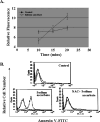L-ascorbic acid (vitamin C) induces the apoptosis of B16 murine melanoma cells via a caspase-8-independent pathway
- PMID: 12827307
- PMCID: PMC11032859
- DOI: 10.1007/s00262-003-0407-6
L-ascorbic acid (vitamin C) induces the apoptosis of B16 murine melanoma cells via a caspase-8-independent pathway
Abstract
L-ascorbic acid (vitamin C) has been reported to play a role in the treatment and prevention of cancer. However, its specific mechanistic pathways remain obscure. This study was carried out to identify the sodium ascorbate-induced apoptotic pathway in B16F10 murine melanoma cells. Sodium ascorbate was found to induce the apoptosis of B16F10 murine melanoma in a time- and dose-dependent manner, and this was prevented by pretreatment with N-acetyl- L-cysteine (NAC), a well-known antioxidant. In fact, sodium ascorbate-treated B16F10 melanoma cells showed increased intracellular reactive oxygen species generation (ROS) levels. These results indicate that sodium ascorbate induced apoptosis in B16F10 murine melanoma cells by acting as a prooxidant. We examined the involvement of caspase-8 using a specific caspase-8 inhibitor (z-IETD-fmk) on the sodium ascorbate-induced apoptotic pathway. Cell death was found not to be inhibited by z-IETD-fmk treatment, indicating that sodium ascorbate-induced apoptosis is not mediated by caspase-8. In addition, we detected a reduction in the mitochondrial membrane potential during apoptosis and confirmed cytochrome-c release from mitochondria by immunoblotting. Taken together, it appears that the induction of a prooxidant state by sodium ascorbate and a subsequent reduction in mitochondrial membrane potential are involved in the apoptotic pathway of B16F10 murine melanoma cells, and that this occurs in a caspase-8-independent manner.
Figures




References
Publication types
MeSH terms
Substances
LinkOut - more resources
Full Text Sources
Medical

